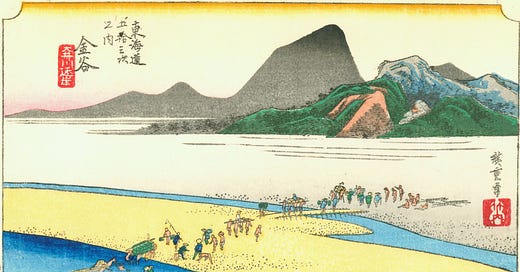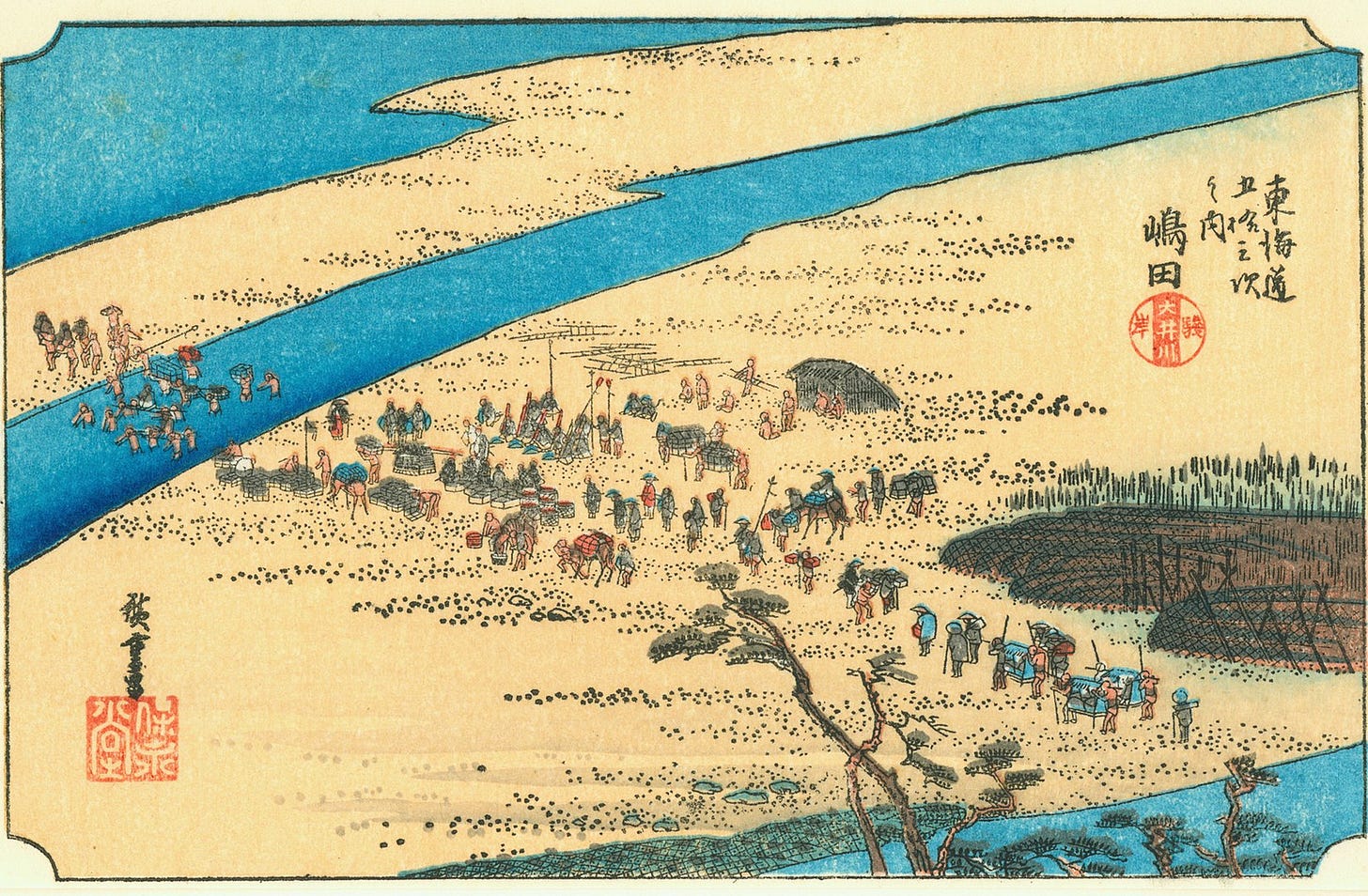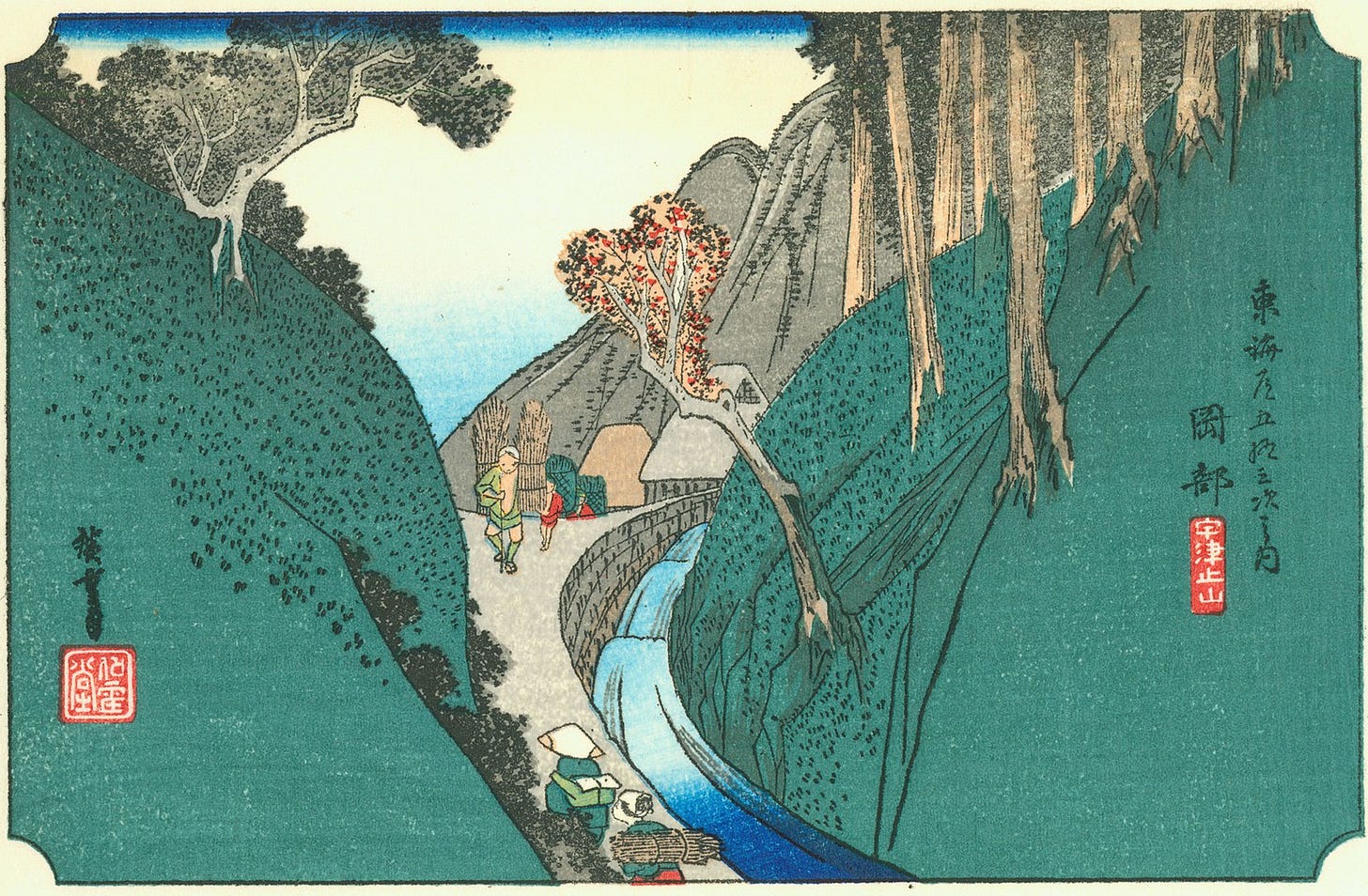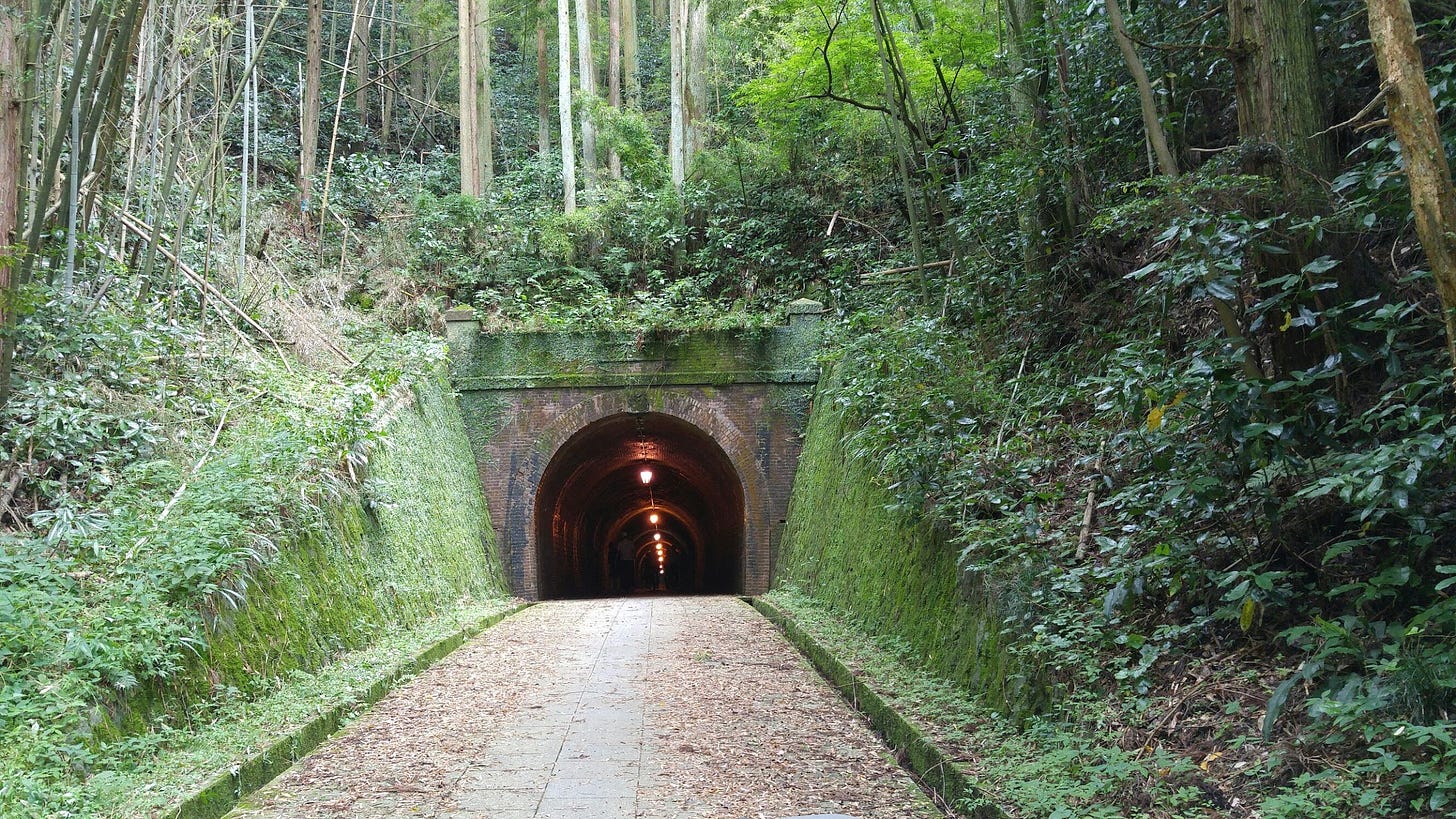I hobbled across the long, dark bridge to Shimada, away from the concerned looks of the Indian restaurant staff, and over the wide, gravelly expanse of the Oi River. Far below the lights caught a fox skittering away, head down, like a mangy jackal.
Crossing the Oi River at Kanaya back in Hiroshige’s day. The wide, gravelly expanse remains, flooding only for short periods remains today. Luckily there are now full-length bridges to cross the river. (Wikimedia Commons)
The Oi River seems to have been wider then, before the construction of embankments. The river gravel blends into marsh and reed, and finally the pines of Shimada are visible. (Wikimedia Commons)
The operating theater was a footbridge, unlikely to be used at this time of the evening. The lighting was provided by a conveniently located street lamp, the sterilisation by a collection of spiders and their associated webs that would at least trap any flies that came near. I peeled off my socks and checked the damage. Both feet had developed enormous blisters once again, right across the bottom. The one on the right foot had burst, revealing a glace cherry of raw red under-skin through the icing of moist deflated blister-skin. I drained the left blisters, same technique as before, and dried out and put a big sticking plaster over the carnage on the right foot. Then baby powder over everything - socks, feet, sandals.
I staggered off to find somewhere to sleep. I found a park, similar to the one by the Tenryu River, but the constant toing and froing of cars driving down to perform odd midnight exercises and who-knows-what-else made sleep impossible. I gave up, re-found the Tokaido and walked towards the centre of Shimada. I realised that this was probably one of the more attractive parts of the Tokaido - old houses, quaint little parks, a little stream in a channel alongside the street. But it was dark, so I couldn't appreciate it fully.
Near the station, I found a park. An oasis of calm in what appeared to be the centre of Shimada’s nightlife. Occasional rowdy groups or couples would pass, but none seemed to come through the park, so in the end, I spread out my sleeping mat on a bench and slept.
In the early light of dawn, I found the station toilet. It had a washlet - oh thank you Japan! I successfully cleaned myself up, applied steroid cream and baby powder to the crotch and set off to find some breakfast.
Showa-era shuttered shops, mile after mile. Of course, when you want a convenience store, they can’t be found. God, I needed breakfast! Vending machine coffee, rusting corrugated sheets, dry cleaners, Suzuki repair shop, Mazda repair shop. And then a long curve through suburban housing. But still no convenience store.
My feet were uncomfortable, but not actually painful. Like walking on slightly soggy cornflakes with pins and needles. I stopped regularly to repowder my feet. Then, finally, a Family Mart, the green white and blue sign, like a beacon, spotted over the roofs of houses off to the left. I stayed there a long time, eating chocolate croissant and watching the traffic, as long as I reasonably could.
The first few steps after putting my rucksack back on were the worst. I kept moving, slowly, but was extremely reluctant to stop. I didn’t stop to take photographs of the old Tokaido stone markers in Fujieda. In fact, I didn’t even take any photos at all, even when I reached Shizuoka. All I could think about was making it to the hotel.
I crossed an ornate bridge over the Seto river, into the centre of Fujieda. More Showa-era shops, slightly less shuttered than before. Faded signs advertised shops that were just hanging on. One sign advertised “shoes and weather”, and the shop did sell shoes - baskets of Crocs and Japanese-style flip flops out at the front and boxes of old-person shoes inside. I couldn’t see where the weather came in though - shoes for all weathers? I passed a Starbucks, but felt self-consciously too scruffy for such an establishment.
The pass at Utsunoya/Okabe - idyllic Tokaido scenes. (Wikimedia Commons)
Despite my slow walking, the early start meant I was going to cross the Utsunoya Pass in the heat of the middle of the day. I toiled up alongside Route One, through a truck park and then onto a shaded lane. It felt hugely familiar, very similar to crossing the Suzuka Pass way back near Lake Biwa. The Tokaido became a path for the first time since then - winding its way up through towering cedars to the Utsunoya Tunnel - a brick tunnel from the early Meiji period, exactly like the one right back at the start, just outside Kyoto. This tunnel I could walk through though. The dripping coolness was a relief from the heat outside. And then out into a steeply-sloping village of wooden houses. The walking was so pleasant at this point that I forgot about my feet - it was classic tourist brochure Tokaido scenery.
The Utsunomiya Tunnel, a Meiji-era brick tunnel. (Robert Gilles-Martineau: Google Earth)
Back onto Route One, trucks howling past, chrome flashing in the sun. I’d taken a long break at the rest area just past the tunnel, so it was mid-afternoon now. Past Mariko-Juku, following the Maruko River as it dropped towards the sea. The mountains opened out to reveal the great plain of the Abe River, and on the far side of that, my hotel! I checked the check in time again - 4pm. I could do it!
A tea house at Mariko. (Wikimedia Commons)
When I reached the centre of Shizuoka, I rested for a long time again outside the station.
“Hello”
I was in a good mood and the guy was in a wheelchair, so I was better disposed to him than the lady who shouted at me from a car. In fact, I was more likely to get an interesting conversation.
“Hello”, I smiled.
“Where are you from?”
“I’m from England.”
“Do you know Simon Robinson?” See - a more interesting conversation!
I confessed that I didn’t. Who was he I wondered. Somebody famous, a footballer that I hadn’t heard of?
“He was my English teacher at school!” I couldn’t really tell how old he was - maybe thirty? So this was more than ten years ago.
“Sorry, no you don’t. I just wondered!” and with that he laughed, span his wheelchair 360 degrees and sped off towards the station.
My good mood ran out at the hotel. It had an automatic check-in. A whole series of steps had to be followed to get the key and get in my room, which I had precious little patience for. When my photo from my ID failed to register, I started swearing profusely. Finally it registered, but then they needed a photo of me in the entrance. While the photo was being taken I was shouting “wankers!” The photo turned out to be a short video which for some reason was played back to me three times so the lobby was filled with the sound of me shouting “wankers!” repeatedly. I hoped nobody in the hotel management would know what this word meant - the obscurity of English swear words is a blessing in Japan. Eventually I got in my room, had my first shower for three days and collapsed on the bed.










Another great, fun episode. You should pitch this saga to Netflix or a Japanese broadcaster. Honest!
BUT you should have crashed the Staba gates. Those overpriced wankers!
I have a bloody feet story myself, and it is set in Shizuoka too. Lost my way back to my hotel and kept running around for hours. I'll make it public one of these days.